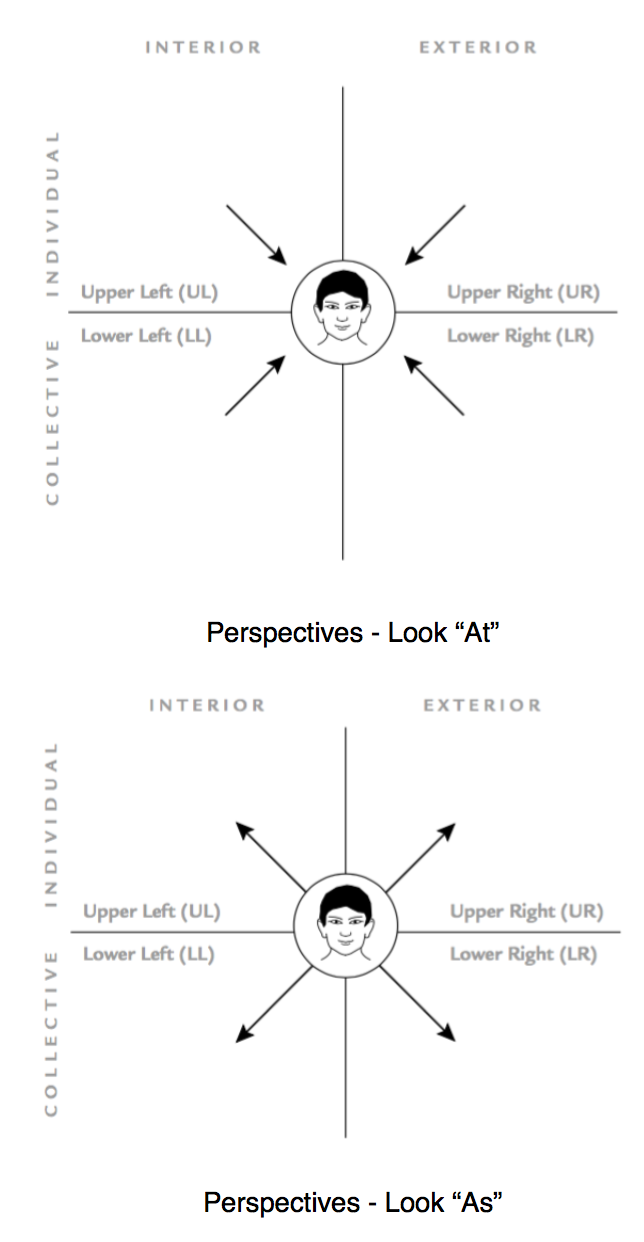 One of the compelling beauties of Integral Theory are repeating patterns, the fractal nature of quadrants, repeating patterns are observable at every scale. This is fundamental and creates a wonderful window onto ourselves, our biases and preferences. It is powerful – working with the integral quadrants becomes a way of differentiating our awareness and learning how to identify ourselves and others from these perspectives – through this differentiating practice, real integration becomes possible.
One of the compelling beauties of Integral Theory are repeating patterns, the fractal nature of quadrants, repeating patterns are observable at every scale. This is fundamental and creates a wonderful window onto ourselves, our biases and preferences. It is powerful – working with the integral quadrants becomes a way of differentiating our awareness and learning how to identify ourselves and others from these perspectives – through this differentiating practice, real integration becomes possible.
We’re exploring Integral Theory’s quadrants* as this opens greater potential for impact and agency on difficult, stuck and complex problems that are inherent to fields such as sustainability, health and business futures – see last week’s post, Beyond the boxes, about this blog series.
A key distinction that assists seeing and working with the quadrants is the  concept of looking at and looking as. We can look at ourselves or anything – e.g. a group of people or a collection of objects – or we could adopt a perspective of seeing such quadrants as ourselves or others.
concept of looking at and looking as. We can look at ourselves or anything – e.g. a group of people or a collection of objects – or we could adopt a perspective of seeing such quadrants as ourselves or others.
Try a simple example. Imagine you are looking at another person, someone you’re emotionally close to. Obviously, you can see that person, the contexts and surroundings they are in. You may identify what you think are their emotional states (happy, sad, angry etc.) and the cultural influences (e.g. are they in a fun social situation) at play for them – you’re looking at them. Next, think about and imagine their experience. What are they seeing at the moment, experiencing physically from the environment around them? How do you think they would describe their cultural context at the moment or emotional state? In doing this you’re looking as them.
The reflective or contemplative nature of this is important. For example, as Sean Esbjörn Hargens illustrates, a therapist has an emotional dimension of themselves and that enables them to see the emotional dimension of a client – they can look at the client and see the emotional dimension of the client. They can only do this as they have this emotional dimension built into themselves. They could not see the emotional dimension without this (or if they could it would be much more conceptual).
Encouragingly, as this theory holds, you can’t reduce these four quadrant dimensions – any sentient being has these four dimensions. This opens a window onto the groups, things, objects and problems we seek to have impact with. Sean highlights, the fact that I have these four dimensions in my own embodied selfness enables me to take these four [integral quadrant] perspectives. I can [consequently] look at the world through these for windows … that is similar and slightly different from those four dimension that are part of myself.
This is an important embodied piece. When we’re working with complex situations and many moving variables – such as considering effective and sustainable future business opportunities – there are an exponential number of parts, influences and perspectives. Quadrants are a way of reflecting ourselves back at ourselves that helps to bring around, as an object of awareness, our own preconceptions so that we can then operate in an enhanced way of being. In essence, we are taking what is subjective and becoming more aware of our biases, seeing our tendencies reflected back to us as our unit of analysis, to become more conscious. In doing so, we can shift what we were subject to to be objective.
Working with quadrants in this way helps us start to see the fractal nature of our world – systems within systems. But, before we disappear down the rabbit hole (that’s next week!) is this practical and what comes from such consideration for the things and outcomes we care about?
There are some real advantages. Looking as, for example an object, does stretch our thinking and it helps to design the object better. From the earlier example, try differentiating which of your perspectives are looking at a person and which are looking as that person, how they may consider that same outlook for themselves. No doubt you already do this when thinking about people you are close to but I find this distinction creates subtle (and sometime not so subtle) insight. That’s a very valuable thing.
* For an Overview to Integral Theory see Sean Esbjörn Hargens pdf here>>>
** Looking at and as perspectives diagram from Sean Esbjörn Hargens, TetraDynamics (2014).
